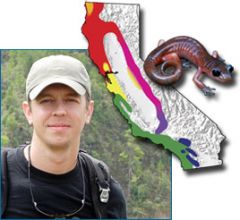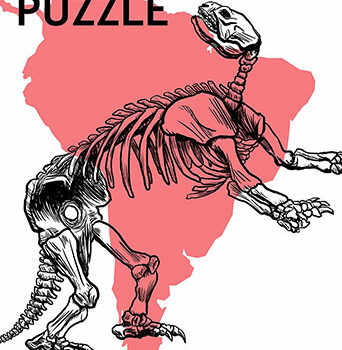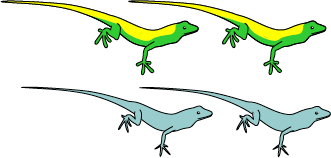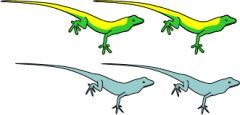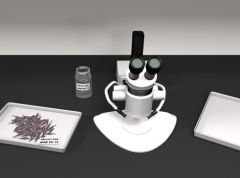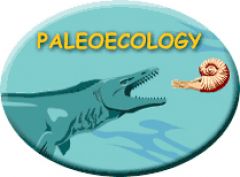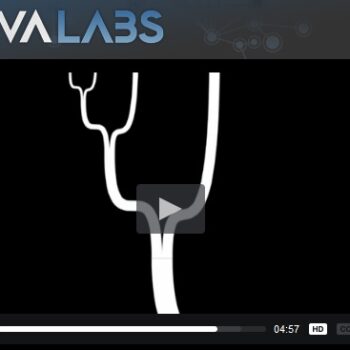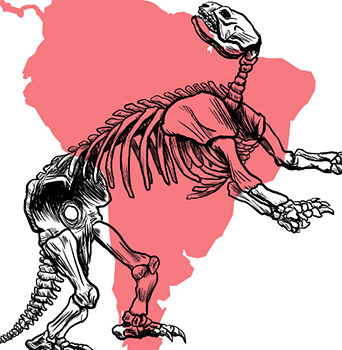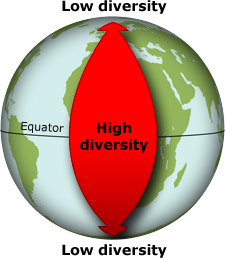Found 13 resources for the concept:
Scientists use the geographic distribution of fossils and living things to learn about the history of life.
A closer look at a classic ring species: The work of Tom Devitt
Grade Level(s):
- 9-12
- 13-16
- General
Source:
- UC Museum of Paleontology
Resource type:
- Research profile
Time: 40 minutes
Overview
The Ensatina salamander has been extensively investigated because it is a ring species — a species that demonstrates how geography and the gradual accumulation of genetic differences factor into the process of speciation. Biologist Tom Devitt continues the more than 50 years of Ensatina research by applying new genetic techniques and asking new questions about this classic evolutionary example.
A Pleistocene Puzzle: Extinction in South America
Grade Level(s):
- 6-8
- 9-12
- General
- Student
Source:
- UC Museum of Paleontology
Resource type:
- Comic
Time: 20 minutes
Overview
In this comic, you'll follow the investigation of scientists Maria and Miguel as they solve a paleontological mystery. About 11,000 years ago, more than 80% of the large animal species in South America went extinct. Why did it happen? (Available in English and Spanish)
Anolis Lizards
Grade Level(s):
- 9-12
Source:
- Collins, Jennifer
Resource type:
- Lab activity
Time: Two class periods.
Overview
Students "take a trip" to the Greater Antilles to figure out how the Anolis lizards on the islands might have evolved.
Darwin’s Great Voyage of Discovery
Grade Level(s):
- 9-12
Source:
- WGBH
Resource type:
- Article
Time: One to two class periods
Overview
Students learn about Darwin's voyage on the Beagle by reading excerpts from his letters and journals and mapping his route.
Evidencias de la Evolución: La ciencia de la evolución
Grade Level(s):
- 6-8
- 9-12
- General
Source:
- UC Museum of Paleontology
Resource type:
- Tutorial
Time: 30-40 minutes
Overview
Island biogeography and evolution: Solving a phylogenetic puzzle using molecular genetics
Grade Level(s):
- 9-12
- 13-16
Source:
- Filson, R.P.
Resource type:
- Lab activity
Time: Two full class periods
Overview
Students focus on the evolution of three species of lizards using real data sets — geographical and geological data, then morphology, and finally molecular data — to determine possible phylogenetic explanations.
Lines of evidence: The science of evolution
Grade Level(s):
- 6-8
- 9-12
- General
Source:
- UC Museum of Paleontology
Resource type:
- Tutorial
Time: 30-40 minutes
Overview
The theory of evolution is broadly accepted by scientists — and for good reason! Learn about the diverse and numerous lines of evidence that support the theory of evolution.
Stickleback Evolution Virtual Lab
Grade Level(s):
- 9-12
- 13-16
Source:
- Howard Hughes Medical Institute
Resource type:
- Online activity or lab
Time: 3 hours
Overview
This virtual lab teaches skills of data collection and analysis to study evolutionary processes using stickleback fish and fossil specimens.
Stories from the Fossil Record
Grade Level(s):
- 6-8
- 9-12
Source:
- UC Museum of Paleontology
Resource type:
- Online activity or lab
Time: One to two class periods
Overview
This web-based module provides students with a basic understanding of how fossils can be used to interpret the past.
The Evolution Lab
Grade Level(s):
- 9-12
Source:
- NOVA Labs
Resource type:
- Lab activity
Time: 3 hours
Overview
The Evolution Lab contains two main parts. In the first, students build phylogenetic trees themed around the evidence of evolution, including fossils, biogeography, and similarities in DNA. In the second, students explore an interactive tree of life and trace the shared ancestry of numerous species.
The Monterey Pine through geologic time
Grade Level(s):
- 9-12
- Advanced
- General
Source:
- Perry, Frank
Resource type:
- Article
Time: 30 minutes
Overview
Understanding the evolutionary history of the Monterey Pine may help us conserve this species.
Un rompecabezas Pleistoceno: Extinctión en América del Sur
Grade Level(s):
- 6-8
- 9-12
- General
- Student
Source:
- UC Museum of Paleontology
Resource type:
- Comic
Time: 20 minutes
Overview
En este comic podrás seguir la investigación que hicieron María y Miguel para resolver un misterio paleontológico. Hace más de 11000 años, más del 80% de las especies de grandes animales de Sudamérica se extinguieron. ¿Por qué pasó? (Disponible en inglés, español y portugués.)
Visualizing life on Earth: Data interpretation in evolution
Grade Level(s):
- 9-12
- 13-16
Source:
- UC Museum of Paleontology
Resource type:
- Online activity or lab
Time: 2 hours
Overview
This web-based module leads students through an exploration of the patterns in the diversity of life across planet Earth. Students are scaffolded as they practice data interpretation and scientific reasoning skills.

